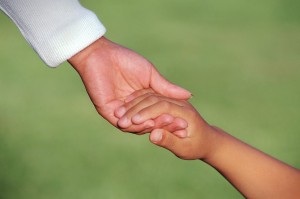We parent the way we were parented. That’s our instinct. If we want to parent a different way we have to make a conscious effort to change. It’s as simple as that, but it’s not easy. Fighting our instincts never is. Too often I hear myself say things to my child that my parents would have said to me. I recognise where these negative responses are coming from, and I’m not happy with them. Sometimes I feel angry and frustrated that I can’t always be the parent I want to be, and it would be so easy to simply blame my parents for this. However, as one of Dan Siegel’s patients once said to him; it’s not my fault, but it’s my responsibility. For me, this seems to make sense of things so well, and is a phrase I’ve often returned to since I heard Dr Siegel talking about it at a conference some two years ago.
 You see, these negative responses that are ingrained in me may not be my fault, but it’s my responsibility to recognise where they’re coming from, the effect they can have on my child, and to self-reflect, and try to make changes for the better.
You see, these negative responses that are ingrained in me may not be my fault, but it’s my responsibility to recognise where they’re coming from, the effect they can have on my child, and to self-reflect, and try to make changes for the better.
Now, following this logic, one could argue that in a similar way those negative responses that my parents passed down to me were not their fault either, since they inherited them from their own parents. But it was their responsibility. And this is where I’m struggling.
It’s only since becoming a parent myself that I’ve fully understood the profound effect my childhood has had on me. But despite this, and the emotional scars I’m still dealing with, I never really felt I held any of it against them. I’ve always known they never meant any harm.
And perhaps things could have stayed this way, with the past lying dormant. But it’s hard to let the past lie when it gets dragged into the present in the form of my parents’ negative responses to my own child. If not for this, I might have been able to leave it all undisturbed.
But since I have gone to the trouble to break the cycle, to get informed and learn about children’s emotional needs, and to take the business of parenting seriously, their behaviour towards my child is more than a little irritating to me. It really triggers something in me. It opens old wounds and makes me feel furiously protective of my own child.
Exacerbating the situation is their judgement and criticism of the way I choose to parent. No, I’m not doing it the way you did – that’s the point! Their inability to see this illustrates their total lack of self-reflection and refusal to take responsibility for themselves. And given the amount of self-reflection I’ve had to do, I find myself increasingly astonished and out of patience with the total lack of it I observe in other people.
But perhaps they know really, and it’s just too much to face up to. Because if they were to admit that what I’m doing is preferable to what they did, they would have to admit that what they did was wrong, had some ramifications. And that’s big.
Relations are now decidedly strained, for the first time since I was a teenager. And just as when I was a teenager, I seem to be expected to shoulder all the responsibility for this.
But the thing is, after years of victim blaming on their part (I was such a difficult teenager, you see), I’ve come to see that the situation back then, the culmination of everything that was wrong in our relationship, was entirely of their own making. After all these years they still can’t face up to this, nor, it seems, to the part they have played in creating the current situation.
Well I have enough responsibility of my own to deal with now, and I have enough issues from my childhood, thanks very much. I am no longer willing to take on anyone else’s. I know it’s not their fault, but it’s their responsibility.



 Posted by Jo
Posted by Jo 








